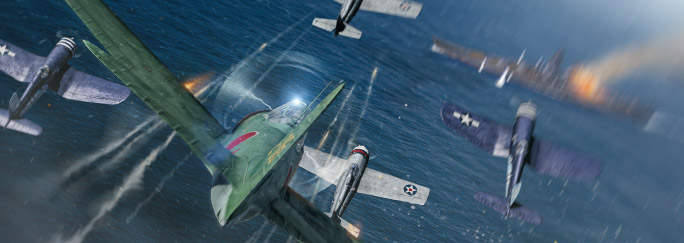-
![LANG-CODE-KEY]() LANG_NAME_KEY
LANG_NAME_KEY

Pilots,
It’s October again! Naturally that means that we couldn’t pass up the opportunity to remind our history-loving fans of one of the biggest naval and aerial battles of the South Pacific – the Battle of Leyte Gulf. After covering it last year, we bring the epic encounter back for another round in the spotlight. This time, however, the game is no longer in Beta and has progressed significantly, which is why we’re able to bring you better bonuses, greater discounts and enticing missions. Check out the details of the 2014 edition below and scroll all the way down to the bottom if you feel like taking a stroll down memory lane in our dedicated History Flashback!
| ‘Battle of Leyte Gulf’ Special | ||
|---|---|---|
| In-game Offers | Special Mission | History Flashback |
|
All offers and missions will be available |
||
Double Crew XP
Double your crew’s progression as you take in double the crew XP this weekend!
50% discount on all ammunition
If you’ve always wanted to try that pricey Premium Ammunition, now’s the time as you’ll be spending only half the usual cost!
50% discount on the following planes
 |
Brewster F2A Buffalo |
|||
 |
Mitsubishi A6M1 Zero |
|||
 |
Grumman F4F Wildcat |
|||
 |
Mitsubishi A6M2 Zero |
The iconic aircraft that fought the Battle of Leyte Gulf are all discounted this weekend. So take your pick!
Take a seat in your U.S. or Japanese planes and recreate the battle in-game by hunting anybody with a star or a sun on their aircraft for extra bonuses!
| Mission: Fight for Leyte Gulf I | |
|---|---|
|
Goal |
Destroy at least 1 U.S. enemy aircraft and win the battle flying the required aircraft. |
|
Reward |
1 x Pneumatic Restarter |
|
Conditions |
Must be flying Japanese aircraft |
| Mission: Fight for Leyte Gulf II | |
|---|---|
|
Goal |
Win a battle and become one of the top 3 experience earners on your team flying the required aircraft. |
|
Reward |
1 x 120-octane Gasoline |
|
Conditions |
|
After their initial success at Guadalcanal in 1942 and subsequent advance in the first Battle in the Philippines around the Northern Mariana Islands in the summer of 1944, the Americans had established a dominant position in the South Pacific. Having suffered painful losses, the Imperial Japanese Navy was largely depleted of capable ships, aircraft and pilots. It was forced to retreat and assume a defensive position, trying to save what little it had left. To add insult to injury, Japanese forces relied heavily on their established supply routes from captured territories on the Philippines and Taiwan. These became increasingly difficult to defend against the well-supplied U.S. forces.
Knowing they had their opponent on the ropes, President Roosevelt and his trusted military advisers decided to attack the weakest link in the Japanese defence line. General Douglas MacArthur was designated to lead the charge and overtake the Central Philippine Islands by launching an amphibious attack on Leyte Island. The landings were backed by the 7th Fleet under the command of Vice Admiral Thomas Kinkaid and the 3rd Fleet under the command of Admiral William Halsey. The Fleets were supposed to circle the gulf and provide air support with their prolific F4F and F4U fighters.
Although the Japanese leadership knew that their naval forces couldn’t match the American juggernaut, they felt that they had no other choice but to try to repel the invasion. Retreating from the Philippines would have meant a slow but inevitable defeat. Blinded by propaganda about the strength of their own spirit, the Japanese hoped to overcome the numerical and technological odds and stop the Americans in their tracks. This would give them more favourable conditions to open the door for an honourable peace. So they mustered up all their available battleships, carriers, aircraft and military personnel and met the U.S. fleet in the Gulf of Leyte with full force.
The action began on October 23rd and lasted four days. There were four major battles, involving over 200 warships, thousands of planes and more than 200,000 sailors and airmen. The Japanese managed to sink a couple of U.S. ships – mostly by using desperate kamikaze attacks, which were employed for the first time during this conflict. However, they failed to inflict enough damage to stop the American advance. Being severely outnumbered, the Japanese lost 4 aircraft carriers, 3 battleships, 8 cruisers, 12 destroyers, almost 400 planes, and 10,000 men. At the same time, Allied losses were much lighter – 3 carriers, 3 destroyers and 200 planes, with a total of around 2,500 casualties.
The Battle of Leyte Gulf was the last straw for the once mighty Imperial Japanese Navy. After this third failed attempt to turn the course of the war in the South Pacific, it never sailed to sea again in comparable force. Most of what remained of the Japanese fleet, deprived of fuel, remained in its bases until the end of the war.
The Pacific Ocean is calling, pilots!